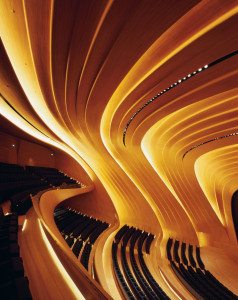To call Zaha Hadid a pioneer may be an understatement.
Revolutionary? Iconoclast? Bold? Radical?
Perhaps they all could be applied to Ms. Hadid, whose death on Thursday (March 31) stunned the architecture world—and the wider world.

Zaha Hadid. Credit: Brigitte Lacombe
Ms. Hadid, 65, was, you see, one of those architects whose fame and impact extended well beyond architecture, design or building construction circles. She was in that exclusive class of groundbreaking architects whose influence extended outward, creating a global brand in the neighborhood of a Calatrava, Gehry, Piano, Pei, Foster, or Koolhaas…and of predecessors such as van der Rohe, Le Corbusier, Kahn. Wright may claim a neighborhood all his own, but Hadid and the others were right up the street.
“It is with great sadness that Zaha Hadid Architects have confirmed that Dame Zaha Hadid, DBE, died suddenly in Miami in the early hours of this morning,” read a statement posted on the firm’s website on Thursday. “She had contracted bronchitis earlier this week and suffered a heart attack while being treated in hospital.”
The statement said Ms. Hadid “was widely regarded to be the greatest female architect in the world today,” and the assertion would get little argument. Wide recognition of her work was catalyzed by the Vitra Fire Station in Weil Am Rhein, Germany, in 1993, Zaha Hadid Architects said.
Then followed a series of major commissions and creations, including these relatively recent works:
- MAXXI: National Museum of 21st Century Arts in Rome (2009)
- London Aquatics Center for the 2012 Olympic Games (2011)
- Heydar Aliyev Centre in Baku (2013)
This trio illustrates her “quest for complex, fluid space,” the firm said.

Heydar Aliyev Center, Baku. Credit: Helene Binet/RIBA
Two other recent projects “have been hailed as architecture that transforms our ideas of the future with visionary spatial concepts defined by advanced design, material and construction processes” – Rosenthal Center for Contemporary Art in Cincinnati (2003) and the Guangzhou Opera House in China (2010).
Pritzker Prize winner
Ms. Hadid was the only woman to receive the Pritzker Architecture Prize, one of the world’s top architecture honors, and was a two-time winner of Great Britain’s top architecture honor, the Royal Institute of British Architects’ (RIBA) Stirling Prize—for the MAXXI Museum in Rome and the Evelyn Grace Academy in England (2011).
Ms. Hadid was recently awarded RIBA’s Royal Gold Medal, the first woman to receive the honor.
Born in Baghdad in 1950, Ms. Hadid studied mathematics at the American University of Beirut, then took up architecture at the Architectural Association in London. She established her own practice, Zaha Hadid Architects, in London in 1979, and gained early recognition with works that included projects that were never constructed–The Peak in Hong Kong (1983), the Kurfürstendamm in Berlin (1986), and the Cardiff Bay Opera House in Wales (1994).
Her design for The Peak in Hong Kong, though never executed due to issues related to Hong Kong’s return to Chinese jurisdiction, won an international design prize as a result of Ms. Hadid’s “spectacular” drawings and paintings. The design is credited with rocketing Ms. Hadid to international fame.
Zaha Hadid Architects said information would be announced regarding a memorial service. Messages of condolence can be sent to pa@zaha-hadid.com.



